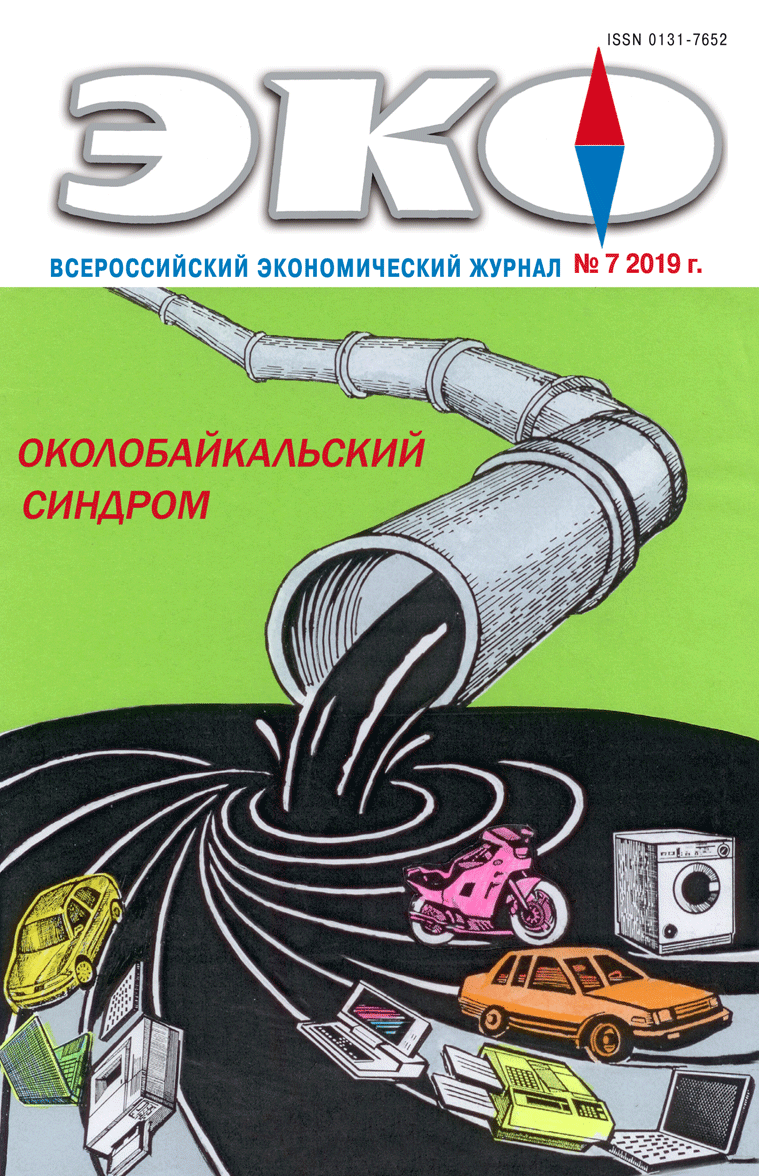DEVELOPMENT OF THE NORTH AND THE ARCTIC
Published 2019-07-02
Keywords
- Arctic zone,
- municipality,
- municipal budget,
- incomes,
- social services
How to Cite
1.
Emelyyanova Е, Chapargina А. Expenditure of Municipalities Budget and Population Incomes in the Russian Arctic. ECO [Internet]. 2019 Jul. 2 [cited 2025 Dec. 20];49(7):80-98. Available from: https://ecotrends.ru/index.php/eco/article/view/3844
Abstract
The objective of this study is to assess the budget security of the Arctic municipalities and the wage level of the Arctic population in socially important sectors – education and health. The research covered three areas: analysis of budget suffciency of the population of Arctic municipalities in the social sphere; analysis of the living standard and incomes of working-age population in the urban districts of the Russian Arctic in key social areas of activity; prospects of social orientation of municipal budgets of the Russian Arctic. The novelty of the research is determined by integrated study of budgets and personal well-being of the population using the authors’ methodology for assessing the state participation in the life of the population, which allowed forming a number of proposals to improve social protection of the population of the Russian Arctic zone. The main conclusion is that social security of the population in the urban districts of the Russian Arctic is decreasing every year. The main reason for this is reduction of budget expenditures on education and health, a slowdown in wage growth in these sectors. Therefore, further development of socially important sectors needs to be supplemented by budgetary or extra budgetary resources that may involve such forms of collaboration as PPP.References
- Абдулгамидова Д. А. Заработная плата как ключевой аспект современного рынка труда // Теория и практика общественного развития. 2015. № 4. С. 73–75.
- Вылегжанина А. О. Некоторые социально-экономические проблемы развития арктических территорий [Эл. ресурс] // Экономический портал: федеральный образовательный портал. URL: http://institutiones.com/general/3038-nekotorye-socialno-ekonomicheskie-problemy-razvitiya-arkticheskih-territorii.html (дата обращения: 17.07.2018).
- Иванова Н. В. Социальное инвестирование: обзор зарубежных практик // Гражданское общество в России и за рубежом. Высшая школа экономики. 2013. № 3. С. 31–36.
- Колесникова К. И. Частно-государственное партнерство: опыт зарубежных стран и перспективы для России // Вопросы управления / Уральский институт – филиал РАНХиГС. 2008. № 3(4). URL: http://vestnik.uapa.ru/ru/issue/2008/03/16/
- Коокуева В. В. Оценка состава и структуры расходов федерального бюджета на социальную политику // Молодой ученый. 2017. № 8. С. 109–112.
- Ларченко Л. В., Колесников Р. А. Дифференциация социально-экономического развития арктических регионов России// Инновации. 2017. № 10 (298). С. 69–75.
- Регионы Севера и Арктики Российской Федерации: современные тенденции и перспективы развития / Под. ред. Т. П. Скуфьиной, Н. А. Серовой. Апатиты: КНЦ РАН. 2017. 171 с.
- Финансовое обеспечение развития северных регионов / Р. В. Бадылевич, Е. Н. Барашева, Т. И. Барашева, Е. А. Вербиненко, Н. В. Дядик, Т. А. Зубарева, Г. В. Кобылинская, В. В. Кобылинский, Д. С. Крапивин, Т. М. Пачина, Г. П. Почивалова, А. Н. Чапаргина, Л. В. Чупенко / Под науч. ред. Г. В. Кобылинской. Апатиты: КНЦ РАН. 2016. 193 с.
- Чапаргина А. Н. Об инвестиционной активности сбережений населения в арктических регионах // Север и рынок: формирование экономического порядка. 2017. № 3 (54). С. 29–37.
- Чистобаев А. И., Малинин П. Ю. Арктическая зона Российской Федерации как особый объект государственного управления // Региональные исследования. 2016. № 2(52). С. 122–128.
- Afonso A., Schuknecht L., Tanzi V. Income Distribution Determinants and Public Spending Efficiency. The Journal of Economic Inequality, 2010.Vol. 8. Iss. 3. Pp. 367–389. Available at: https://doi.org/10.1007/s10888–010–9138-z
- Dresscher W., Harris B. Public Private Partnerships in Education. A report by Education International, 2009, 184 p.
- Herrera S., Pang G. Efficiency of Public Spending in Developing Countries: An Efficiency Frontier Approach. World Bank Policy Research Working Paper, 2005, no. 3645, 67 p. Available at: http://documents.worldbank.org/curated/en/262621468135939068/pdf/wps3645.pdf
- Hodge G. A., Greve C. Public-Private Partnerships: An International Performance Review // Public Administration Review, 2007. Vol. 67 (3). Pp. 545–558.
- Jafarov E., Gunnarsson V. Government Spending on Health Care and Education in Croatia: Efficiency and Reform Options. IMF Working Papers, no. 08/136, 2008, 34 p. Available at: http://www.imf.org/external/pubs/ft/wp/2008/wp08136.pdf
- OECD Better Life Index. Norway, 2018 Available at: http://www.oecdbetterlifeindex.org/countries/norway/
- Patrinos H. A., Barrera-Osorio F., Guáqueta J. The Role and Impact of Public-Private Partnership in Education. Washington, D.C.: The International Bank of Reconstruction and Development, 2009, 116 p.
- The Arctic Social Indicators report, Copenhagen, 2016, 303 p. Available at: https://www.sdwg.org/wp-content/uploads/2016/04/Arctic-Social-Indicators-II.pdf

